Digital Poster
Cardiac Function I
ISMRM & ISMRT Annual Meeting & Exhibition • 03-08 June 2023 • Toronto, ON, Canada

| Computer # | |||
|---|---|---|---|
4675.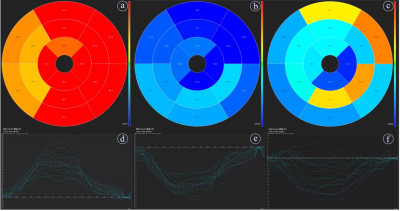 |
81 |
The value of CMR feature tracking (FT) technique in quantitative
assessment of left ventricular myocardial strain in cardiac
amyloidosis (CA)
Jia Liu1,
Jianxing Qiu1,
Wei Li1,
Jiangkai He1,
Kai Zhao1,
and Jianxiu Lian2
1Peking University First Hospital, Beijing, China, 2Philips Healthcare, Beijing, China Keywords: Myocardium, Cardiovascular, Cardiac magnetic resonance,Feature tracking,Strain,Cardiac amyloidosis Subjects were divided into light-chain amyloidosis (AL-CA), transthyretin-related amyloidosis (ATTR-CA) and control group. CMR-FT technique was used to measure apical, middle and basal strain of left ventricle. Results showed ICC value was higher than 0.9 in all strain parameters, and meanwhile all strain parameters in AL-CA group and ATTR-CA group were lower than those in control group except for apical RS. However, there was no statistical difference between the AL-CA group's and ATTR-CA group. Strain evaluation could evaluate patients of CA, which may provide evidence for the treatment and diagnosis of CA. |
|
4676.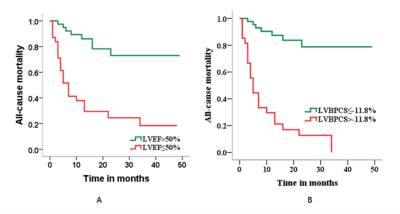 |
82 |
Cine magnetic resonance images: relationship to therapeutic
effect evaluation and prognosis in light-chain amyloidosis
Keyan Wang1,
Jie Zheng2,
Jing An3,
and Jingliang Cheng1
1MRI, The First Affiliated Hospital of Zhengzhou University, Zhengzhou, China, 2Mallinckrodt Institute of Radiology, St. Louis, MO, United States, 3Siemens Healthineer, Shenzhen, China Keywords: Cardiomyopathy, Myocardium The study evaluated left ventricular (LV), right ventricular (RV), and left atrial (LA) myocardial strain and heart function derived from cine magnetic resonance (MR) imaging for chemotherapeutic efficacy and predicted their prognostic value in patients with light-chain (AL) amyloidosis. Our results demonstrated that these parameters may be noninvasive imaging markers allowing assessment of the chemotherapeutic effect and may offer independent prognostic information for all-cause mortality in patients with AL amyloidosis. |
|
4677. |
83 |
Application of CMR-FT technique in the assessment of cardiac
function and prognosis in patients with myocardial amyloidosis
Jianing Cui1,
Tao Li1,
Xiuzheng Yue2,
and Chuncai Luo1
1Radiology, the First Medical center, PLA General Hospital, Beijing, China, 2Philips Healthcare, Beijing, China Keywords: Heart, MR Value, cardiac magnetic resonance-feature tracking Early diagnosis of cardiac amyloidosis (CA) and accurate assessment of cardiac function is important for CA patients. LV strain and strain rate obtained by cardiac magnetic resonance-featured tracking (CMR-FT) have been developed as sensitive indicators of myocardial function. This study aimed to evaluate myocardial function in patients with CA by strain and strain rate to assess their prognostic value in patients with CA. Our data showed that strain rate could be used to assess the degree of cardiac impairment in CA and the difference with HCM providing prognostic information for all-cause mortality in CA patients. |
|
4678. |
84 |
MRI for the assessment of pre-treatment regional cardiac
dysfunction in thoracic cancer patients
El-Sayed H. Ibrahim1,
Antonio Sosa1,
Jadranka Stojanovska2,
Lindsay Puckett1,
Elizabeth Gore1,
and Carmen Bergom3
1Medical College of Wisconsin, Milwaukee, WI, United States, 2New York University, New York, NY, United States, 3Washington University, St Louis, MO, United States Keywords: Heart, Heart Radiation therapy (RT) plays a key role in treating thoracic cancer, although the incidence of RT-induced cardiac complications could be as high as 33%. Nevertheless, characterization of baseline heart function, myocardial tissue characteristics and hemodynamic parameters in this patient population is not well elucidated, which was investigated in this study. The results revealed suboptimal cardiac function (both systolic and diastolic) and associations between different MRI cardiovascular parameters at baseline. Therefore, the condition of the cardiovascular system at baseline should be taken into consideration as a contributing factor in the development of RT-induced cardiotoxicity in thoracic cancer patients. |
|
4679. |
85 |
Assessment of early anthracycline-induced cardiotoxicity using
segmental strain of cardiac magnetic resonance : an animal study
junqi liu1,
qianfeng luo1,
wanyin qi1,
zhengyuan xiao1,
xiaoyong zhang2,
xingyuan kou1,
and jing chen1
1The Affiliated Hospital of Southwest Medical University, Luzhou, China, 2Clinical Science, Philips Healthcare, Chengdu, China, Chengdu, China Keywords: Cardiomyopathy, Cardiomyopathy This study investigated segmental strain to evaluate early anthracycline-induced cardiotoxicity on a 1.5T MR system in New Zealand rabbits models. The apical lateral wall and the anterior apical wall have a statistical difference corresponding to the pathological results in the second week. The ejection fraction showed statistical difference at the eighth week, while the global strain was not even statistically significant. The result showed that the peak segmental strain was earlier than the peak global strain and cardiac function, which may provide an effective and convenient monitoring method for chemotherapy patients. |
|
4680.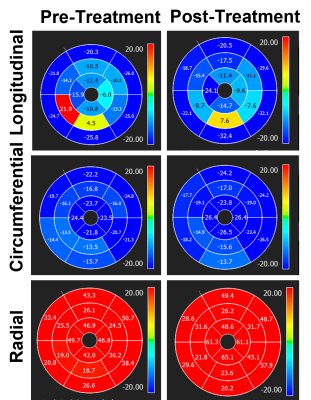 |
86 |
Myocardial strain and strain rate reveal changes on regional
cardiac function shortly post chemotherapy
El-Sayed H. Ibrahim1 and
John Charlson1
1Medical College of Wisconsin, Milwaukee, WI, United States Keywords: Heart, Cancer Anthracycline chemotherapy is the mainstay of cancer treatment. While the most important late, potentially permanent, side effect of chemotherapy is cardiotoxicity, the short-term acute effects of chemotherapy on cardiac function are not well elucidated. In this study, we used advanced cardiac MRI to assess subclinical changes in cardiac function immediately post chemotherapy treatment. The results demonstrated that strain and strain rate are sensitive imaging parameters that allow for early detection of changes in systolic and diastolic myocardial contractility immediately post chemotherapy despite slight changes in global cardiac function and tissue characterization. |
|
4681.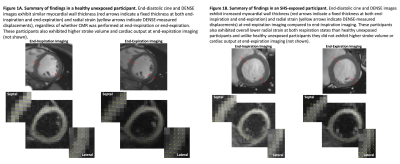 |
87 |
Differences in Myocardial Strain at End-Inspiration versus
End-Expiration with Remote Exposure to Secondhand Tobacco Smoke
Huiming Dong1,
Ang Zhou1,
Natalie Au2,
Mehrdad Arjomandi2,
and Dimitrios Mitsouras1
1Radiology and Biomedical Imaging, University of California, San Francisco, San Francisco, CA, United States, 2Divisions of Pulmonary, Critical Care, Allergy, and Sleep Medicine and Occupational and Environmental Medicine, University of California, San Francisco, San Francisco, CA, United States Keywords: Myocardium, Myocardium, Cardiopulmonary; Second-Hand Smoker Prolonged exposure to secondhand tobacco smoke (SHS) is associated with abnormal pulmonary function and cardiovascular response. In this study, we examined cardiac function in SHS-exposed participants using cardiac MR (CMR) and displacement encoding with stimulated echoes (DENSE) to determine whether the cardiac function is affected by air trapping-a hallmark of heavy past SHS exposure. We found that SHS-exposed participants had lower myocardial radial strain than unexposed participants at both end-inspiration and end-expiration imaging. Neither stroke volume nor cardiac output exhibited the decrease seen in unexposed participants at end-inspiration, but radial strain was significantly lower compared to end-expiration in SHS-exposed participants. |
|
4682.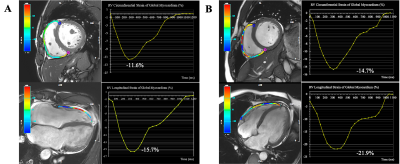 |
88 |
Pulmonary Hypertension Detection by Cardiac Magnetic Resonance
Feature Tracking in Patients with Left Heart Failure
Yunling Li1,
Kai Yang2,
Xiuyu Chen2,
Jianxiu Lian3,
Yong Sun1,
and Shihua Zhao2
1Department of Cardiology, The Second Affiliated Hospital of Harbin Medical University, Harbin, China, HarBin, China, 2Department of Magnetic Resonance Imaging, Fuwai Hospital, State Key Laboratory of Cardiovascular Disease, National Center for Cardiovascular Diseases, Beijing, China, 3Beihang University, Beijing, China Keywords: Heart, Cardiovascular, Heart failure To investigate the relationship correlation of cardiac magnetic resonance (CMR) feature tracking (FT)-derived right ventricular (RV) global longitudinal strain (RV-GLS) and RV global circumferential strain (RV-GCS) with mean pulmonary artery pressure (mPAP) and pulmonary vascular resistance (PVR) to explore the diagnostic value of RV strain parameters in advanced left heart failure patients with pulmonary hypertension (PH). Study findings included as following: (a) CMR-FT RV-GLS and RV-GCS were independent risk factors for PH in patients with end-stage left heart disease, among all CMR imaging parameters; (b) Both RV-GCS (AUC = 0.868) and RV-GLS (AUC = 0.873) were valuable in predicting PH. |
|
4683.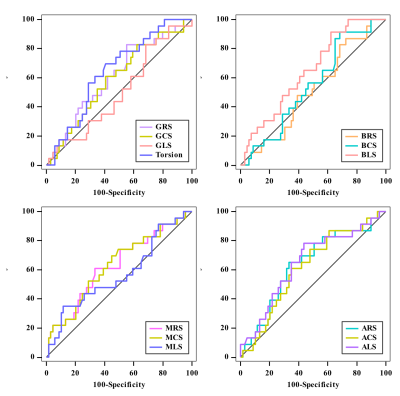 |
89 |
Analysis of segmental strain in identifying HCM with and without
outflow tract obstruction
Jianxiu Lian1,
Shengliang Liu2,
Yunling Li2,
Guokun Wang2,
Xueying Wang2,
Ye Li2,
Xiaofang Xu1,
and Yanming Zhao2
1Philips Healthcare, Beijing, China, 2The Second Affiliated Hospital of Harbin Medical University, Harbin, China Keywords: Cardiomyopathy, Cardiomyopathy, hypertrophic obstructive cardiomyopathy, hypertrophic non-obstructive cardiomyopathy Hypertrophic cardiomyopathy (HCM) can be divided into two types according to pressure gradient of left ventricular outflow tract, which means different prognosis and risk stratification. Feature tracking technology can be used to calculate strain value in three orientations and evaluate the ability of myocardial deformation. Our results showed that strain differences can be detected between HCM and control group. Segmental strain and torsion also showed significant differential value between hypertrophic obstructive cardiomyopathy (HOCM) and hypertrophic non-obstructive cardiomyopathy (HNOCM) group.Our study may provide evidence in differentiating HOCM and HNOCM for further treatment. |
|
4684. |
90 |
Diagnostic value of myocardial strain for evaluating pig model
in ischemia with non-obstructive coronary artery disease
Zilong Ren1,
Didi Wen2,
Jianxiu Lian3,
Jiantao Liu3,
Zhe Huang3,
and Minwen Zheng4
1Department of Radiology, Xijing Hospital, Fourth Military Medical University, Xi'an, China, 2Department of Radiology, Xijing Hospital, Forth Military Medical University, Xi'an, China, 3Philips Healthcare China, Xi'an, China, 4Xijing Hospital, Fourth Military Medical University, Xi'an, China Keywords: Myocardium, Animals To explore whether myocardial strain can predict functional changes for ischemia with non-obstructive coronary artery disease (INOCA) in animal models. Results showed pigs with INOCA had lower global circumferential strain (GCS) and global longitudinal strain (GLS) (mean GCSnormal = -20.2 ± 2.0 %, mean GCSINOCA = -16.6 ± 1.4 %, P = 0.009; mean GLSnormal = -19.6 ± 1.9 %, mean GLSINOCA = -14.5 ± 3.0 %, P = 0.027). Therefore, the results showed that the myocardial deformation decreased in pigs with INOCA, which could provide information for the therapy of INOCA patients. |
|
4685.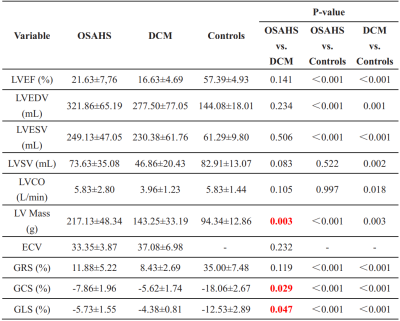 |
91 |
CMR Myocardial Strain Analysis in Discriminating Obstructive
Sleep Apnea-Hypopnea Syndrome Induced Heart Failure and Dilated
Cardiomyopathy
Xiao Du1,
Jian Wang1,
Jian Yao1,
Ruopeng Wang1,
Mengyue Han1,
Tiantian Yang1,
YingCui Zhu1,
Chenglin Xu1,
Zheng Jing1,
Deyue Yan1,
Baijie Li1,
and Xiuzheng Yue2
1Central Hospital Affiliated to Shandong First Medical University, Jinan, China, 2Philips Healthcare, Beijing, China Keywords: Heart, Cardiovascular, Cardiac magnetic resonance; Obstructive sleep apnea-hypopnea syndrome; Dilated cardiomyopathy The obstructive sleep apnea-hypopnea syndrome (OSAHS) patients with heart failure and dilated cardiomyopathy (DCM) patients all show left ventricular dilatation and systolic dysfunction as the main phenomenon. Still, there are very few reports on identifying the two diseases. Herein cardiac magnetic resonance (CMR) myocardial strain technology was used to evaluate the cardiac function and myocardial structure of the OSAHS and DCM patients. The results showed that the global peak circumferential and longitudinal strains and the left ventricular myocardial mass of the DCM group were lower than the OSAHS group. This research provides reference for the identification of these two diseases. |
|
4686.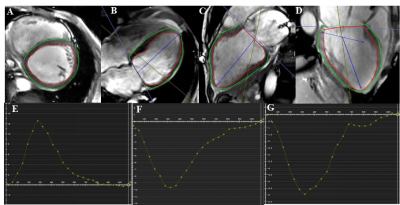 |
92 |
Impact of malignant ventricular arrhythmia on left ventricular
function in dilated cardiomyopathy patients assessed by CMR
feature tracking
Ao Kan1,
JianKun Dai2,
Shuhao Li1,
MengYao Hu1,
and Lianggeng Gong1
1The Second Affiliated Hospital of Nanchang University, Nanchang, China, 2GE Healthcare, Beijing, China Keywords: Cardiomyopathy, Cardiomyopathy, Cardiac magnetic resonance This study aiming at assessing the impact of malignant ventricular arrhythmia (VA+) on left ventricular (LV) function in dilated cardiomyopathy (DCM) patients using cardiovascular magnetic resonance (CMR) feature tracking (FT). 34 VA+ and 39 VA- (benign) DCM patients were measured with CMR cine imaging. Although the left ventricular ejection fraction was similar between these two groups, FT results showed the global longitudinal peak strain (GLS) was significantly lower in VA+ than in VA-. GLS had certain diagnostic value for differentiate VA+ and VA- in DCM patients. Glycosylated hemoglobin (HBA1c) was an independent determinant parameter for GLS in DCM patients. |
|
4687.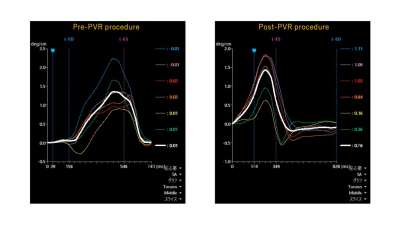 |
93 |
Three-dimensional left ventricular torsion after pulmonary valve
replacement in repaired tetralogy of Fallot: motion tracking
analysis
Yurie Shirai1,
Michinobu Nagao2,
Atsushi Yamamoto1,
Kei Inai3,
Takeshi Shinkawa4,
Seiko Shimizu5,
and Shuji Sakai1
1Diagnostic Imaging and Nuclear Medicine, Tokyo Women’s Medical University, Shinjuku, Japan, 2Tokyo Women’s Medical University, Shinjuku, Japan, 3Pediatric Cardiology, Tokyo Women’s Medical University, Shinjuku, Japan, 4Cardiovascular Surgery, Tokyo Women’s Medical University, Shinjuku, Japan, 5Canon Medical, Chuo, Japan Keywords: Heart, Cardiovascular In patients with repaired tetralogy of Fallot (TOF), pulmonary regurgitation is a frequent complication, resulting in right heart failure. Pulmonary valve replacement (PVR) should be performed before irreversible heart failure occurs. Pulmonary regurgitation disappears and RV volume decreases with PVR. Interventricular interactions are expected to improve left ventricular (LV) function, but in some cases LV function is not restored. We analyzed pre- and post-PVR cine cardiac MRI (CMR) with a motion tracking technique to quantitatively assess LV deformity in three dimensions. As a result, a decrease in preoperative LV torsion was a useful predictor of postoperative worsening LV function. |
|
4688.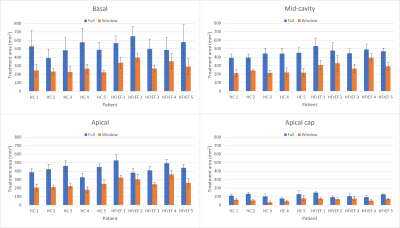 |
94 |
Using cardiac magnetic resonance imaging to assess advantages of
cardiac-gated radioablation
Justin Poon1,2,
Richard B Thompson3,
Marc W Deyell4,
Devin Schellenberg5,
Kirpal Kohli6,
and Steven Thomas2
1Department of Physics & Astronomy, University of British Columbia, Vancouver, BC, Canada, 2Department of Medical Physics, BC Cancer - Vancouver, Vancouver, BC, Canada, 3Department of Biomedical Engineering, University of Alberta, Edmonton, AB, Canada, 4Heart Rhythm Services and Centre for Cardiovascular Innovation, Division of Cardiology, University of British Columbia, Vancouver, BC, Canada, 5Department of Radiation Oncology, BC Cancer - Surrey, Surrey, BC, Canada, 6Department of Medical Physics, BC Cancer - Surrey, Surrey, BC, Canada Keywords: Arrhythmia, Radiotherapy, cardiac radioablation Cardiac magnetic resonance (CMR) images and tracked left ventricle (LV) contour points were used to investigate the advantages of a cardiac-gated radioablation treatment for ventricular tachycardia. Contour points were divided into 17 segments of the LV. Individual segments were treated as hypothetical targets, and an optimal treatment window was determined where cardiac motion was minimal. Target centroid displacement and treatment area were quantified for the treatment window and the full cardiac cycle. Using a cardiac-gated radioablation treatment would allow for reduced treatment margins and minimize the dose delivered to surrounding normal tissue. |
|
4689.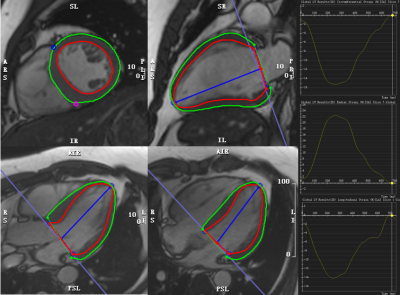 |
95 |
The evaluation of short- and mid-term effects of sleeve
gastrectomy on left ventricular function in obesity: a
prospective CMR study
Lu Tang1 and
Jiayu Sun1
1Department of Radiology, West China Hospital, Sichuan University, Chengdu, China Keywords: Heart, Myocardium, obesity; left ventricular function; cardiac magnetic resonance This study investigate left ventricular function of obese patients with no known heart disease who underwent laparoscopic sleeve gastrectomy (LSG) by cardiac magnetic resonance (CMR) in their short- and mid-term postoperative follow-up. We found that obese patients who underwent LSG had a significant decrease in body weight, left ventricular mass and left ventricular cavity in the short- and mid- term postoperative. In the mid-term postoperative, the left ventricular subclinical systolic dysfunction of left ventricle significantly improved. |
|
4690.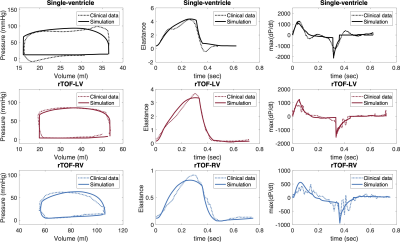 |
96 |
Cardiovascular MRI combined with catheterization for objective
assessment of cardiac function: data- and model-derived
pressure-volume loops
Maria Gusseva1,2,3,
Daniel A. Castellanos4,
Tarique Hussain1,
Dominique Chapelle2,3,
and Radomír Chabiniok1,2,3,5
1Department of Paediatrics, UT Southwestern Medical Center, Dallas, TX, United States, 2Inria, Palaiseau, France, 3Ecole Polytechnique, Palaiseau, France, 4Department of Cardiology, Boston Children’s Hospital, Boston, MA, United States, 5Czech Technical University in Prague, Prague, Czech Republic Keywords: Heart, Modelling Clinical pressure-volume data are often subjected to measurement noise. In the present work we explore the potential of a biomechanical model of the heart as a data-filtering tool. We use cardiovascular MRI volume data either simultaneously or sequentially acquired with catherization. We use time-varying elastance metrics for a quantitative comparison of data- and model-derived pressure-volume loops (PV loops). Our results demonstrate that the biomechanical model provides high quality PV loops that could be used to replace noisy data signals. In addition, this work contributes to the increased understanding of cardiovascular MRI results. |
|
4691.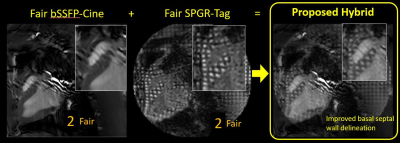 |
97 |
A Multi-Sequence SSFP-SPGR One-Breath-Hold Cine-Tag MR – Extent
of Hybrid Artifact Interference
Jacob Goes1,2,
Vivian S Nguyen1,2,
Donovan Gorre3,
Timothy J Carroll3,
Jihye Jang4,
Marcella K Vaicik1,
Jouke Smink5,
Amit R Patel6,
Jeremy A Silvnick2,
and Keigo Kawaji1,2
1Biomedical Engineering, Illinois Institute of Technology, Chicago, IL, United States, 2Medicine - Cardiology, University of Chicago Medical Center, Chicago, IL, United States, 3Radiology, University of Chicago Medical Center, Chicago, IL, United States, 4Philips, Gainesville, FL, United States, 5Philips, Best, Netherlands, 6Medicine, University of Virginia, Charlotesville, VA, United States Keywords: Myocardium, Preclinical A single-breath-held (BH) cine and tag MRI offers a hybrid SSFP-SPGR contrast approach with potential to provide quantitative measures of regional myocardial wall motion. Such approaches overcome the need for inter-BH misregistration during conventional, multi-sequence acquisition. In this study, we examine the extent of artifact interferences that manifest by means of the bypassed pre-scan calibration steps for the less sensitive SPGR-tag scan. A consecutive cohort of 25 subjects that yielded ~400 cine- and tag-volumes were retrospectively analyzed to examine the prevalence of artifact, interference with motion assessment, and the rate of yielding assessable wall motion via the hybrid one-breath-hold approach. |
|
4692. |
98 |
Performance of compressed-sensing cardiac MR in evaluating left
ventricular function: a systematic review and meta-analysis
Zhaozhao Wang1,
Anqi Yang1,
Zien Zhou2,
Chi Wang3,
Jing An4,
and Yi He1
1Radiology, Beijing Friendship Hospital, Capital Medical University, Beijing, China, 2Radiology, Ren Ji Hospital, School of Medicine, Shanghai Jiao Tong University, Shanghai, China, 3Heart Health Research Center, Beijing, China, 4Siemens Shenzhen Magnetic Resonance Ltd., Beijing, China Keywords: Heart, Heart SSFP-cine CMR imaging has been recommended to evaluate LV function and structure. However, a long scan time limited its widely application. A novel fast CS-cine CMR imaging might be an option, but its accuracy is inconclusive. Therefore, we conducted a systematic review and meta-analysis for it. We included 23 observational studies for pooling. There was no difference in LVEF, LVEDV, LVESV and LVmass, along with no heterogeneity across different subgroups by MR field intensity, breath-holding, children, and arrhythmia (all P for inter-subgroup heterogeneity <0.05). The quality of CS-cine images was acceptable and was superior to SSFP-cine images in arrhythmia patients. |
|
4693.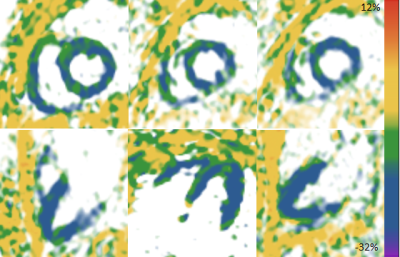 |
99 |
Feasibility of Strain Encoded (SENC) MRI to Assess Cardiac
Contractility on a Commercial 0.55T System
YINGMIN LIU1,
Donel Tani2,
Matthew Joseph1,
Nael F. Osman2,
Mahmood Khan1,
Juliet Varghese1,
and Orlando P. Simonetti1
1Ohio State University, Columbus, OH, United States, 2Myocardial Solutions, Inc., Morrisville, NC, United States Keywords: Cardiomyopathy, Low-Field MRI, Strain In phantom, human volunteers, and an animal model, this study shows the feasibility of strain encoding (SENC) on a commercially available 0.55T low field scanner with limited gradient performance. Measured through-slice strain in a deformation phantom agrees with steady-state free precession (SSFP) cine; global strains in healthy humans fall into the normal expected range; infarcted myocardial segments in a porcine model demonstrated reduced strain. |
|
4694.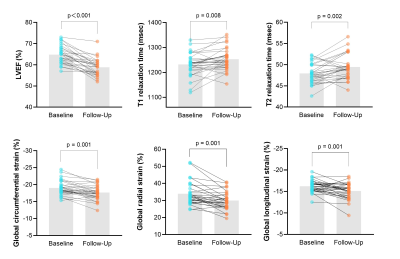 |
100 |
Early evaluation of subclinical cardiotoxicity in HER2-positive
breast cancer patients with low-moderate cardiovascular risk
using MRI
Sainan Cheng1,
Jianwei Wang1,
Yawen Wang1,
Linlin Qi1,
Fenglan Li1,
Jianing Liu1,
Jiaqi Chen1,
Yang Fan2,
and Lizhi Xie2
1Department of Diagnostic Radiology, National Cancer Center/ Cancer Hospital, Chinese Academy of Medical Sciences and Peking Union Medical College, Beijing, China, 2MR Research China, GE Healthcare, Beijing, China Keywords: Heart, Cardiovascular, cardiotoxicity This study explored the early cardiac changes in HER2-positive patients treated with HER2-targeted or anthracycline therapy through cardiac MRI. The results showed frequent signs of subclinical cardiotoxicity after short-term anti-cancer therapy, despite with low-moderate cardiovascular risk. T1 mapping showed the capability for early detection of pathological myocardial changes before cardiac contractile dysfunction. In HER2-positive breast cancer patients, cardiotoxicity surveillance is important and should be carefully done even with low-moderate cardiovascular risk, especially for those received anthracycline-based therapy. |
|
The International Society for Magnetic Resonance in Medicine is accredited by the Accreditation Council for Continuing Medical Education to provide continuing medical education for physicians.